Pushpavat, Puṣpavat: 8 definitions
Introduction:
Pushpavat means something in Hinduism, Sanskrit. If you want to know the exact meaning, history, etymology or English translation of this term then check out the descriptions on this page. Add your comment or reference to a book if you want to contribute to this summary article.
The Sanskrit term Puṣpavat can be transliterated into English as Puspavat or Pushpavat, using the IAST transliteration scheme (?).
In Hinduism
Vedanta (school of philosophy)
Source: Google Books: Studies on the MoksopayaPuṣpavat (पुष्पवत्) means “like a flower”, according to the 10th century Mokṣopāya or Mokṣopāyaśāstra 6.182.13-17.—Accordingly, “With regard to each of [the three:] perceiver (draṣṭṛ), perception (darśana) and perceived objects (dṛśya), the state of mere knowledge is the essence; therefore there is not in the least a difference from it (i.e. knowledge), like a flower in space [i.e., khapuṣpa—khapuṣpa-vat] (is not different from space). (13) What is of the same kind becomes one. Therefore mutual perception [of things] determines their unity. (14) If wood, stones and other [material objects] did not have knowledge as their nature, then there would be a permanent nonperception of these, which would even be nonexistent. (15) When the whole beauty of perceptible objects has but one form of mere knowledge, then, whether it is different or identical, it becomes known through knowledge. (16) This whole [group of] perceptible objects in the world has expanded [as] mere knowledge, just as wind is mere movement and the ocean mere water. (17)”.

Vedanta (वेदान्त, vedānta) refers to a school of orthodox Hindu philosophy (astika), drawing its subject-matter from the Upanishads. There are a number of sub-schools of Vedanta, however all of them expound on the basic teaching of the ultimate reality (brahman) and liberation (moksha) of the individual soul (atman).
Languages of India and abroad
Sanskrit dictionary
Source: DDSA: The practical Sanskrit-English dictionaryPuṣpavat (पुष्पवत्).—a.
1) Blooming, flowery
2) Set off with flowers. -m. (du.) The sun and moon; तेजस्विनौ विराजेते पुष्पवन्ताविवोदितौ (tejasvinau virājete puṣpavantāvivoditau) Śiva. B.2.23; रबित्वचन्द्रत्वाभ्यामेकशक्तिमदेव नियतद्विवचनाकाङ्क्षम् (rabitvacandratvābhyāmekaśaktimadeva niyatadvivacanākāṅkṣam).
-tī 1 A woman in her courses; पुष्पवत्यपि पवित्रा (puṣpavatyapi pavitrā) K.
2) A cow longing for the bull.
Source: Cologne Digital Sanskrit Dictionaries: Shabda-Sagara Sanskrit-English DictionaryPuṣpavat (पुष्पवत्).—mfn. (-vān-vatī-vat) Having flowers, flowery. m. always dual. (-ntī) The sun and moon. f. (-vatī) A woman during menstruation. E. puṣpa a flower, or expansion as at rising, &c. and matup aff.
Source: Cologne Digital Sanskrit Dictionaries: Benfey Sanskrit-English DictionaryPuṣpavat (पुष्पवत्).—[puṣpa + vat], adv. Like a flower or flowers, Böhtl. Ind. Spr. 1876.
Source: Cologne Digital Sanskrit Dictionaries: Monier-Williams Sanskrit-English Dictionary1) Puṣpavat (पुष्पवत्):—[=puṣpa-vat] [from puṣpa > puṣ] 1. puṣpa-vat mfn. (puṣpa-) having f° or decorated with f°, flowery, blooming, [Ṛg-veda] etc. etc.
2) [v.s. ...] m. Name of a Daitya, [Mahābhārata]
3) [v.s. ...] of a man, [Saṃskārakaustubha]
4) [v.s. ...] of a prince, [Harivaṃśa; Purāṇa]
5) [v.s. ...] of a mountain in Kuśa-dvīpa, [Mahābhārata]
6) [v.s. ...] ([dual number]) sun and moon, [Bālarāmāyaṇa; Gaṇitādhyāya] (perhaps [from] -vanta)
7) [=puṣpa-vat] [from puṣpa > puṣ] 2. puṣpa-vat ind. like a f°, [Bhartṛhari]
8) Puṣpāvat (पुष्पावत्):—[=puṣpā-vat] [from puṣpa > puṣ] mfn. = puṣpa-vat1 [Taittirīya-saṃhitā]
Source: Cologne Digital Sanskrit Dictionaries: Yates Sanskrit-English DictionaryPuṣpavat (पुष्पवत्):—[puṣpa-vat] (vān) 5. m. Always dual. Sun and moon. f. A woman during menstruation. a. Flowery.
[Sanskrit to German]
Sanskrit, also spelled संस्कृतम् (saṃskṛtam), is an ancient language of India commonly seen as the grandmother of the Indo-European language family (even English!). Closely allied with Prakrit and Pali, Sanskrit is more exhaustive in both grammar and terms and has the most extensive collection of literature in the world, greatly surpassing its sister-languages Greek and Latin.
See also (Relevant definitions)
Starts with: Pushpavata, Pushpavataka, Pushpavati, Pushpavatika, Pushpavatike, Pushpavativanarajasamkusumitabhijna, Pushpavatiya, Pushpavatuka.
Ends with: Daugdhikapushpavat, Khapushpavat, Phalapushpavat.
Full-text: Jahu, Pushpavati, Satyadhrita, Phalapushpavat, Pupphavati, Satyahita.
Relevant text
Search found 5 books and stories containing Pushpavat, Puṣpavat, Puspavat, Pushpa-vat, Puṣpa-vat, Puspa-vat, Puṣpāvat, Puṣpā-vat; (plurals include: Pushpavats, Puṣpavats, Puspavats, vats, Puṣpāvats). You can also click to the full overview containing English textual excerpts. Below are direct links for the most relevant articles:
The Agni Purana (by N. Gangadharan)
The Shiva Purana (by J. L. Shastri)
Chapter 18 - Seven continents (varṣa) < [Section 5 - Umā-Saṃhitā]
The Vishnu Purana (by Horace Hayman Wilson)
Chapter XIX - Dynasty of Puru < [Book IV]
Abhidharmakośa (by Leo M. Pruden)
Shukra Niti by Shukracharya (by Benoy Kumar Sarkar)